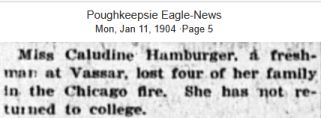|
In 1903
eighteen-year-old Claudine Hamburger▼1 (1885–1969) was a freshman at Vassar College. While home for
the holidays on December 30 she went to an afternoon matinee performance of Mr. Bluebeard
at the city's new luxury playhouse, the Iroquois Theater. Just after the start of the second act a stage fire spread to the
auditorium, killing nearly six hundred people. Claudine escaped, leaving her cloak behind. In the pocket of her cloak
was a claim check for a pin left for repair at a jeweler in Poughkeepsie, NY where Claudine attended school. A month later she
was contacted by Chicagoan S.S. Vaughn who had accidentally carried her cloak away from the Iroquois, mistaking
it for the garment of someone in his theater party, and contacted the jeweler to learn her identity.▼2
She was the daughter of Amelia Regensburg and German immigrant Solomon "Sol" Hamber, a wealthy Chicago businessman.▼3
In 1900 the family lived at 4347 Grand Boulevard. Iroquois Theater manager Will J. Davis' lived across the street at 4340 Grand Blvd.
The Hamburger's had two servants, Davis had one.
Nothing was published about Claudine's theater companions but I doubt she was alone. She had many
relatives in Chicago, including at two least theater parties at the Iroquois — both of whom suffered fatalities. If Claudine sat with
either party, it was not published. Those parties were the Regensburgs and the
Eisendraths. She and the Regensburgs girls were first cousins. (Claudine's mother Millie and Charles Regensburg were
siblings, the children of Samuel Regensburg.) Her grandmother, Adeline Eisendrath, was among the original
twenty-three Eisendraths from Dorsten, Germany and settled in Chicago.
A blurb in the Poughkeepsie Eagle-News newspaper reported that Claudine — then a freshman at Vassar — lost four members of
her family at the Iroquois.

|
|
|
Claudine and her family traveled the world with her parents and siblings in 1906-7, returning shortly before her father's death.
Some of that sojourn was spent studying with celebrated Paris vocal coach,
Mme Mathilde Marchesi.
Claudine's interest in performing was demonstrated by frequent newspaper references to her involvement in student and amateur
theater productions from adolescence to adulthood.
Claudine graduated from Vassar College in 1907. (Not sure how she was in Europe and studying in Poughkeepsie at the same time.)
In 1910 in the Florentine room at Congress Hotel in Chicago she married a Bostonian, Adolf Leeds (1877–1961),▼4
a cotton merchant who had emigrated from Weikersheim, Germany in 1894. They had two daughters.
Claudine embarked on a concert career in the 1920s, singing mezzo-soprano one time with the Boston Pops orchestra directed by Arthur
Fiedler. Though she would thereafter describe herself as a professional singer, I found only amateur performances mentioned in newspapers.
The lack of enthusiasm about her vocalizing makes me wonder if her tryout for the Pops was preceded by a large donation. On the other
hand, friends chose her to sing at their weddings so she wasn't awful, just maybe not skilled enough for stardom.
|

|
Nothing is known of Claudine's happiness quotient but
external signs are that she lived a life many would envy.
Her travel and residences alone suggest she wanted for little. There were two years traveling Europe before marriage, a three-month
honeymoon, a couple months traveling in France and Germany in 1914, (returning shortly before the start of World War I, leading
friends to fear her husband Adolph, a German native, had been pressed into military service in Germany▼5), and spending
the summers of 1925 and 1932 in Europe.
One of their first homes, in 1918, was a six-bedroom 3k sq.ft. townhouse at 192 Bay State Rd. In 1930 the family lived at 232 Woodland
in the Chestnut Hill area of Brookline, Massachusetts, a Boston suburb, in a 6k sq. ft. home estimated to be worth $6 million today. After the
Depression, they moved into a 5.5k sq ft three-million-dollar home at 18 Willard Rd. For a personal nest egg: in 1932 she and her brother
split her mother's quarter-million-dollar estate.
|
|
Discrepancies and addendum
1. Family members sometimes used Hamber, sometimes Hamburger. Claudine's father used "Hamber" on his gravestone but
reported Hamburger to the 1900 U.S. Census enumerator. Claudine used Hamburger until her marriage.
2. At 86 Randolph was
J.C. Vaughan, not S.S. Vaughn. John Charles Vaughan (1850-1924) was considered by some the dean of Chicago horticulturists. In addition
to his retail outlet in Chicago, a few blocks from the Iroquois Theater, he imported and sold by catalog. His
1901 catalog is online.
If you like pen and ink illustrations it contains some nice ones.

3. Sol Hamber built and sold a cigar manufacturing company in Chicago then in 1890 partnered with Antonio Santaella and helped build his
cigar wholesaling company.
4. Leve appears in their marriage records and on Adolf's passport, Leed on his grave Marker.
5. Adolf Leed, then using the name Leve, was co-owner in a German cotton company, Wolf & Soehne. When war broke out he traded
his shares in the German company for ownership of the U.S. portion of the company. Like other cotton brokers in the same position
he began buying and storing cotton, intending to ship it to Germany when the war was over. On the advice of his attorneys the amount
and value of his cotton stores was understated. Upon discovery in May 1918 he was forced to surrender control of the cotton stores. He went on to become president of the Boston Cotton Exchange and his company, New
England Waste, operated offices in Europe and Asia in addition to multiple locations in the U.S. He was an avid yachtsman.
|





